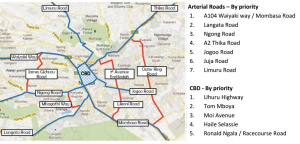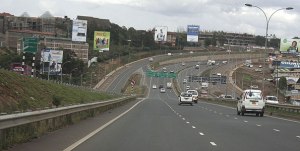Nairobi’s congestion-lack of traffic management and transit planning are evident. Courtesy: The Transport and Urban Decongestion Committee Report 2014.
By Jacqueline Klopp
In 2011 Nairobi’s congestion was ranked 4th worst in the world by International Business Machines Corp.’s Commuter Pain survey. Since then, despite various road construction projects including useful bypasses (now ring roads), conditions have gotten worse. Traffic congestion is on everyone’s minds even more than usual these days (if that is possible) with the ongoing redesign of some of Nairobi’s key roundabouts.
These proposed changes- without a proper traffic decongestion and transport strategy (along with basic legal and institutional changes)- could actually make everything worse. A metropolitan transit authority was recommended in the 1973 Nairobi Metropolitan Growth Strategy, but this recommendation was ignored until recently when the government put together a steering committee to create a Nairobi Area Metropolitan Transit Authority that would finally take ultimate responsibility for traffic and transit planning and management in the region.

The plan for intervention by the Executive Task Force on Nairobi Decongestion (see link to presentation below)
In the mean time, the city and the Ministry must act on a proper set of strategic interventions that address the diverse causes of various structural and management bottlenecks in the flow of traffic, along with the the long term forces like increasing population and car ownership that in the long run will undermine any short term measures. Unless people are given good, efficient and safe transit choices like expanded commuter rail, improved bus services or the ability to ride a bike safely in the city, congestion will be a major problem. So far, the government has been very slow to act on these measures, although with citizen and expert consultation the city county of Nairobi recently developed a very good policy on non-motorized transport (including walking and cycling) and plans for Bus Rapid Transit and improved commuter rail are in the works-although little to no public information is available on these initiatives.
Nairobi needs a proper mass transit system and non-motorized transport infrastructure. For years, the city has neglected much of its transit planning and traffic management responsibilities-the matatu industry, for example, has had to run transit pretty much on its own without the help of planned stops and stations and improved route planning. The Ministry of Transport with international lending institutions have been content to build scattered road projects and more recently transit projects but do not really consult widely, collect open data or monitor the impacts of their interventions.
Take the Nairobi-Thika Highway upgrade project: it failed to include a smart plan for public transit that carries the bulk of the people in the corridor and in the absence of this plan, did not cater for the existing matatu system that does provide service. It ignored pedestrians and cyclists and the infrastructure that was put in as an afterthought is extremely poor. Thika Highway now has a growing congestion problem, a management problem and a traffic violence problem all very likely to grow worse than before. But who is monitoring and will advocate for the public interest?
Nairobi’s gridlock is a symptom of this basic neglect to manage transportation infrastructure, traffic and transit. The problem has finally reached a point where we are seeing some action. Sadly, this is also where some confusion is arising. On 27 January 2014 Governor Kidero commissioned a committee of local experts and stakeholders including the Kenya Alliance of Residents Associations and the Matatu Owner’s Association among others to address Nairobi’s congestion. Led by a respected University of Nairobi professor Dr. Marion Mutugi, this Transport and Urban Decongestion Committee (TUDC) for the first time held a wide ranging set of meetings with Nairobians and experts on how to address congestion. Their recommendations-based on consultations with citizens and diverse local experts from matatu owners to ambulance drivers- are very sensible. You can read the TUDC report handed to the governor here.
So why was the report shelved by the governor? It was surprising to hear last month that a new Executive Task Force on Congestion had formed at the Ministry of Transport and Infrastructure. The Task Force gave a presentation and immediately hired contractors to take out key roundabouts and are planning to redesign matatu routes (without route data, I discovered). You can see the presentation this new executive task force gave last month which provides some information of their plans now moving forward in Nairobi. Why did the Ministry with support from the governor derail a citizen and local expert led, open process for addressing decongestion? Why is an executive initiative planning to tear up roundabouts in the city (which require a proper traffic management system to work!!!) without engaging the work of the TUDC and local experts who are eager to engage in the sort of process needed for sustained change? For too long the transportation sector has been treated as a kind of moneymaking club where citizens and most local experts have no say. If we want to fix congestion in Nairobi, we should go back to the TUDC report and with the support of the committee and all who contributed to it, start from there. The city and the Ministry need to build a transparent and accountable set of steps towards actual traffic management and transport planning based on shared data and public information, citizen and local expert feedback and monitoring. Otherwise, Nairobi, center of almost half the country’s economic production and opportunity, will grind to a halt.
Nairobi Planning Innovations is pleased to also note that the Kenya Institute of Public Policy and Research Analysis has just released a valuable policy brief on Mitigating Road Traffic Congestion in the Nairobi Metropolitan Region.

